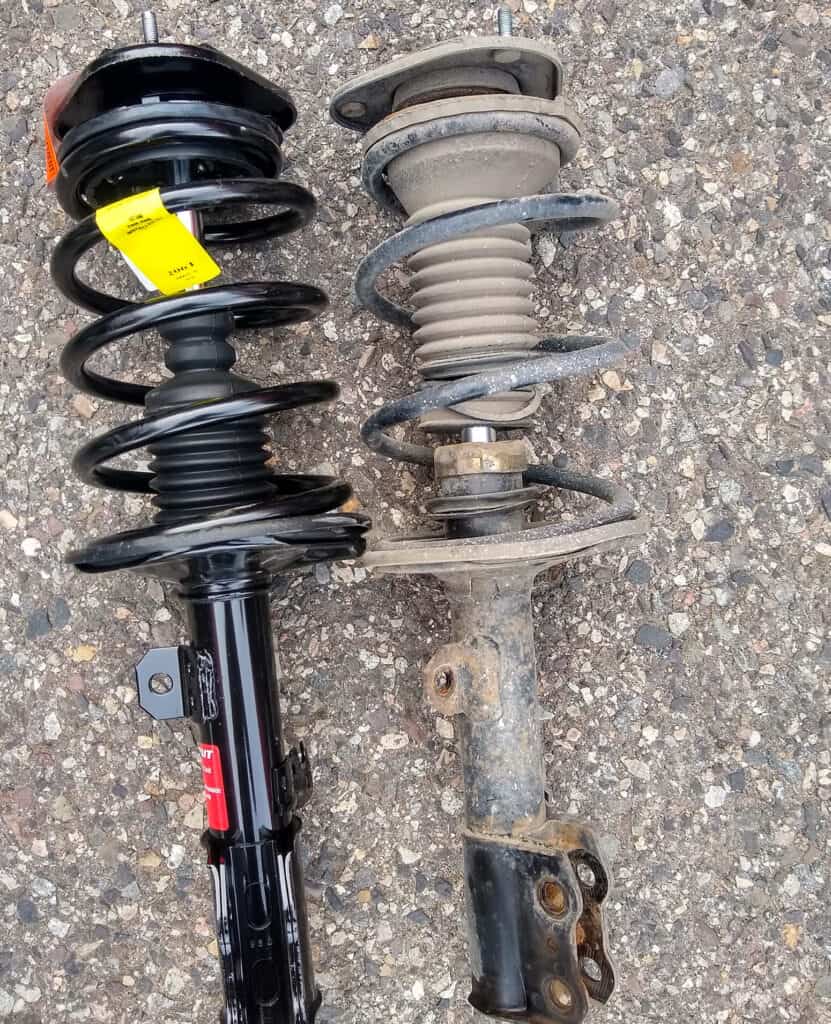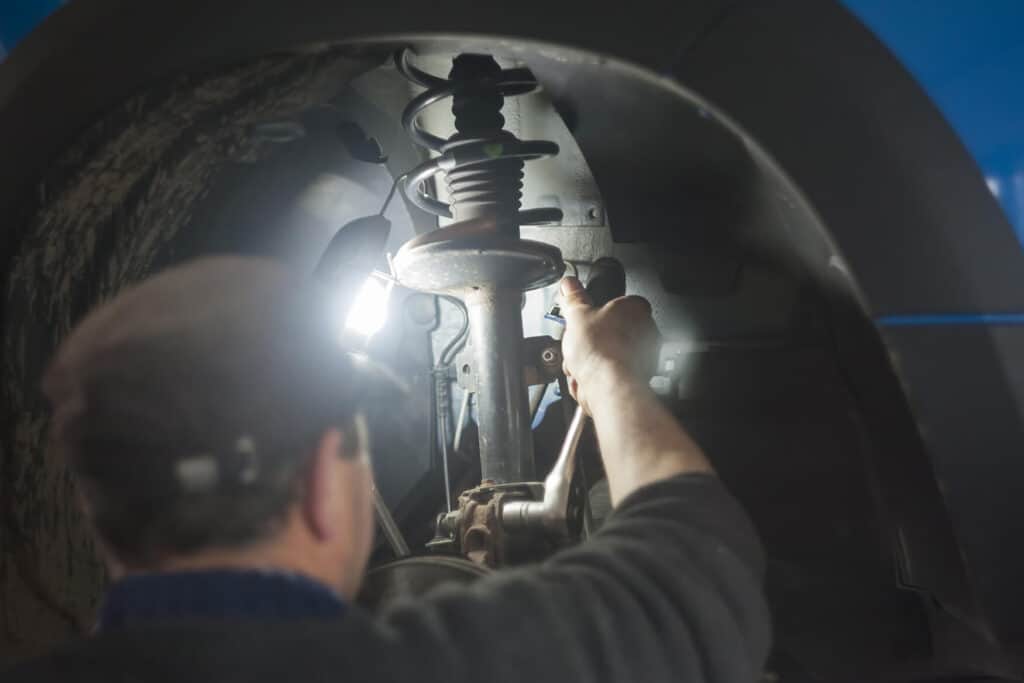The Unsung Heroes of Your Ride — The Importance of Shock Absorbers and Struts
Ever thought about what keeps you comfortable and secure in your car as you navigate potholes, bumps, and sudden turns? Yes, you guessed it—shock absorbers and struts, the unsung heroes of your ride. They’re responsible for a stable driving experience and, more importantly, your safety on the road. How do you know when these hidden heroes are crying out for attention? Let’s find out.
Rough Rides: How Unstable Driving Points to Shock Issues
Imagine gliding down the highway like you’re on a cloud, and then out of nowhere, it feels like you’re in a rodeo. That sudden roughness isn’t just a jarring experience—it’s a sign of deeper issues. When your car’s ride goes from smooth to shaky, the culprit often is the shock absorbers. These components are responsible for absorbing the impact from road irregularities, allowing your vehicle to move steadily. As they wear out or get damaged, their effectiveness dwindles, turning even the most mundane drives into bone-jarring experiences.
But it’s not just about comfort; it’s also a matter of safety. Shock absorbers are crucial for keeping your vehicle’s tires in contact with the road. When they’re not functioning well, your car’s grip on the road lessens, affecting your ability to steer, brake, and maneuver effectively. This becomes even more critical under wet or icy conditions, where poor shock absorber performance can significantly increase stopping distances and compromise vehicle stability. The disconcerting bumps and shakes are more than just inconvenient—they’re warning signs. Ignoring them can put you at a higher risk of accidents due to decreased road grip and braking efficiency.

The Sway Test: What Excessive Leaning Means for Your Struts
You know that feeling when you make a turn, and it’s like your car wants to become a two-wheeler for a moment? You’re not imagining it. If your vehicle leans or sways excessively during turns or when coming to a stop, it might be crying out for new struts. Struts play a crucial role in maintaining your car’s balance and height. They absorb the impact from road irregularities, allowing your vehicle to remain stable and flat. If they’re on the fritz, you’ll start to notice your car behaving more like a pendulum, swaying more than it should.
But the concern isn’t merely an uncomfortable or unnerving ride; it’s a red flag for your vehicle’s safety. Struts are vital for keeping your car balanced, which in turn impacts how effectively you can steer, brake, and maintain control of your vehicle. When they fail, you risk losing stability, especially during sharp turns or abrupt stops. This can be a perilous situation, leading to loss of control and the potential for accidents. It’s not just your imagination—excessive leaning while driving should be a catalyst for immediate action. The risks of procrastinating could range from frequent tire replacements to, in the worst-case scenario, a life-threatening incident. If you’re experiencing this, it’s high time to consult a mechanic to assess the state of your struts and get them replaced if necessary.
Hear That? Strange Noises and What They Could Mean
Your car usually hums along quietly, but then one day, it starts to groan, squeak, or thud. No, it’s not auditioning for a role in a horror movie. These unsettling noises could be a dire warning from your shocks or struts. They’re like your car’s vocal cords, and when they make these strange sounds, it’s your vehicle’s way of crying for help. Typically, these noises will emanate from your suspension system and will become even more noticeable when you hit bumps or navigate rough terrains.
Ignoring these noises is like disregarding a fire alarm. Not only are these sounds disruptive, but they’re also indicative of failing components that can compromise your safety. Damaged shocks and struts can lead to more than just a noisy ride; they can affect your vehicle’s alignment, tire wear, and even its ability to brake effectively. In severe cases, the problem could escalate to the point where your shocks or struts break, causing significant damage to other parts of your vehicle. When you start hearing these unusual sounds, that’s your cue to head to a mechanic post-haste. It might be a minor issue, but it could also be a sign of a major problem lurking beneath the surface. Getting your vehicle inspected at the first sign of trouble can save you money in the long run and more importantly, keep you safe on the road.
The Bounce Test: A Simple DIY Diagnosis Method
Want to play detective? You can perform a simple “bounce test” at home:
Step 1: Park on Level Ground
Make sure your car is parked on a flat, level surface to get the most accurate results from the bounce test. Ensure that the vehicle is in the parking mode and that the ignition is off.
Step 2: Safety First
Position yourself so that you can apply force to the front end of the vehicle without leaning into the car. This is to ensure you won’t accidentally activate any controls while performing the test.
Step 3: Press Down on Front Hood
With your palms flat, press down firmly on the front hood near the corners. Make sure to apply enough pressure to compress the suspension system but not so much that you risk damaging the vehicle.
Step 4: Release and Observe
Once you’ve pressed down firmly, quickly release the hood and step back. Watch how the vehicle reacts.
Step 5: Count the Bounces
If the vehicle bounces back more than two or three times, your shocks or struts are likely worn out. A well-functioning suspension system should stabilize itself almost immediately.
Step 6: Rear-End Test
Don’t forget the rear end! Repeat the same steps at the back of the car to assess the rear shocks and struts.
Step 7: Document Your Observations
Make a note of your findings. If the car is bouncing excessively, this is useful information to relay to your mechanic.
Step 8: Professional Assessment
Even if the test shows no signs of worn-out shocks or struts, it’s always a good idea to get a professional opinion. Sometimes, issues might not be as easily noticeable.
Don’t Ignore the Warning Lights: Dashboard Indicators You Shouldn’t Overlook
• Warning Light Basics: Dashboard lights are your car’s way of communicating problems or malfunctions. Yellow or amber lights usually indicate something that needs to be checked soon, while red lights signify an immediate issue requiring attention.
• Consult the Owner’s Manual: The moment a warning light illuminates, pull out your owner’s manual. Each light has a specific meaning, and your manual will help you decode it.
• Suspension-Related Lights: Some cars have specific warning lights for the suspension system. They may look like a car with two squiggly lines beneath it or even use the word “suspension.”
• Advanced Systems: Newer cars with advanced suspension systems might even pinpoint the problem for you, displaying messages like “Service Ride Control” or “Air Ride Off.”
• Initial Actions: If a suspension-related warning light appears, try to recall any recent instances of rough driving conditions, potholes, or accidents. This context can help your mechanic diagnose the issue.
• Professional Diagnosis: Regardless of what the manual says, if a warning light related to the suspension comes on, it’s a clear indicator that a professional diagnosis is needed.
• Don’t Delay: Ignoring warning lights can lead to further damage and more costly repairs down the line. Act swiftly to keep your ride safe and smooth.

Repair, Replacement, and Costs: What to Do When the Signs Are Clear
If the signs are stacking up, it’s time to take action.
Assessment First, Action Later: Before jumping into any repair or replacement, the first step is to get a thorough diagnosis. Consult a trusted mechanic, preferably one who specializes in suspension systems, to assess the condition of your shock absorbers and struts. Some mobile mechanics even offer this service at your doorstep for added convenience.
Minor Repairs and Quick Fixes: Sometimes, the issue might not be as severe as it seems. Leaks in the hydraulic fluid or minor wear and tear can often be repaired without requiring a full replacement. Costs for these types of repairs generally range from $100 to $300, depending on the complexity.
The Cost of Inaction: Ignoring minor problems can result in more significant issues down the line. Damaged shocks and struts can affect your car’s wheel alignment, tire wear, and even its braking system. Proactive maintenance can save you a lot more than the $200-$1500 you might spend on a full replacement.
When Replacement Is Inevitable: If your mechanic’s assessment points to severe damage, replacement is the best course of action. The typical cost of replacing shock absorbers can vary between $200 and $1500, depending on your vehicle’s make and model. Luxury cars and larger SUVs generally fall on the higher end of the spectrum.
OEM vs. Aftermarket: When it comes to replacements, you generally have two options: Original Equipment Manufacturer (OEM) parts or aftermarket parts. OEM parts are generally more expensive but come with a warranty and the assurance of quality. Aftermarket parts can be more affordable but vary significantly in quality.
Labor Costs: Don’t forget to factor in labor costs, which can add significantly to your total expenditure. Depending on the garage, labor rates can range from $50 to $150 per hour. Mobile mechanics might offer a more competitive rate since they save on overheads by coming to you.
Geographical Differences: Keep in mind that labor and parts costs can vary based on your geographical location. Urban areas might have higher labor costs, but they also offer a wider selection of parts, which could give you a better deal.
Long-term Benefits: Investing in good quality shocks and struts not only ensures a smoother ride but also contributes to the longevity of your vehicle. It’s a direct investment in both your safety and your vehicle’s future.
Beyond the Signs — Maintaining Your Peace of Mind on the Road
Being attentive to these signs can go a long way in ensuring not just your comfort but also your safety on the road. A quick checklist can help you catch problems before they escalate into bigger issues. As part of your vehicle’s routine check-up, don’t overlook the health of your shock absorbers and struts.
If you’re not sure where to start or how to interpret the signs, consider mobile mechanics as a convenient solution. They bring the repair shop to you and can provide professional inspections and repairs right on your driveway. For those based in Canada, Uchanics offers a mobile mechanic service that can help you keep your vehicle’s shock absorbers and struts in top condition. Book an appointment today to give your car the attention it deserves.
